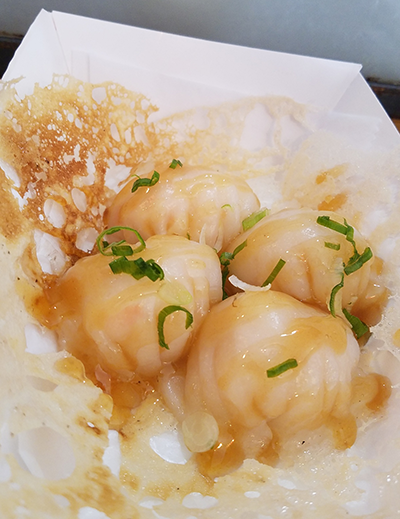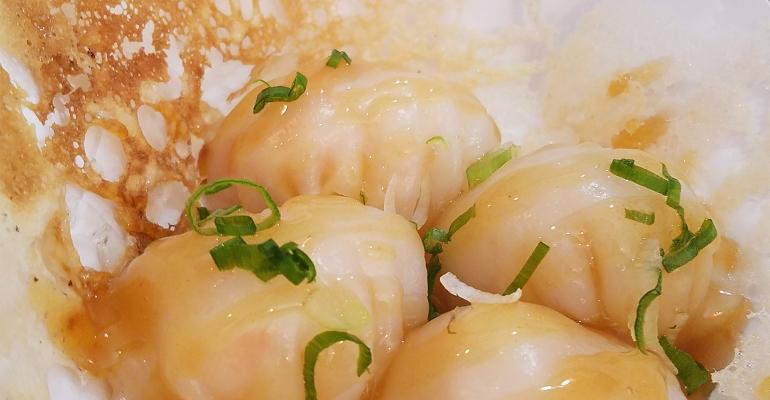 In this special report, we highlight some of the unsung heroes in culinary innovation. Read more about creative approaches to five signature menu items here.
In this special report, we highlight some of the unsung heroes in culinary innovation. Read more about creative approaches to five signature menu items here.
The har gow is one of the hallmarks of Cantonese cuisine. The jiggly shrimp dumpling with nearly translucent skin is one of the three items, along with beggars-purse-shaped shumai and fluffy char siu bao, by which the southern Chinese meal of dim sum is judged, according to Chris Cheung, chef and owner of East Wind Snack Shop with two locations in Brooklyn, N.Y.
 Cheung’s har gow are nestled on a thin, crispy crust instead of the traditional paper lining. (Photos: Chris Cheung)
Cheung’s har gow are nestled on a thin, crispy crust instead of the traditional paper lining. (Photos: Chris Cheung)
Cheung is himself a Cantonese-American, born in Brooklyn with ancestors all from the southern Chinese city of Toisan, and when he told his family and friends that he was going to make a new version of har gow, they were skeptical.
“It would be like putting pineapple on pizza to a New York old-school guy,” Cheung said.
Making a har gow at all is difficult, so difficult that it’s left out of most household celebrations and reserved instead for restaurant visits, Cheung said.
It’s made from a temperamental dough, mostly of tapioca starch and wheat starch, but not wheat protein. It’s gummy, tacky, inelastic and hard to work with.
“It’s traditionally made by having that dough put in a circle,” Cheung said. “Then you have a special cleaver that you slam on the table and spread the skin out.”
Without the elasticity that would be provided by gluten, “It’s not something that you’re going to be able to shape around,” Cheung said. “You have to get the filling amount to the size of the skin just right and then fold it.”
For the filling, shrimp has to be chopped in a particular way, so that when it’s wrapped in the dumpling skin and steamed it has “a coarse but very tight, meaty texture, wrapped with this dough that’s unlike any other dough for dumplings,” Cheung said.
“Even though it was my favorite dumpling, I always felt, could there be something missing here?” he wondered “As a chef, coming from my brain, can we give this a new look?”

His natural instinct was to try pan-frying them, for the simple reason that pan-fried dumplings are delicious. He said it was good, but he wanted something more.
Traditionally har gow are served in little steamer trays, their bottoms stuck to the thin paper lining each tray. Cheung decided that instead of having them stick to paper, he could get them to stick to a thin, crispy tapioca crust.
It took several months of searing the har gow briefly before adding a tapioca slurry, then adding some water, covering it, steaming it to cook the dumplings, then letting the water evaporate, then adding a little more starch and oil to create a lattice-work resting place for the dumplings.
The result is the same gummy, delicious dumplings of Cheung’s childhood, with a bit of added crunch, plus some abalone sauce that reminds him of the dried squid he ate in Chinatown’s movie theaters as a kid.
Cheung said his Cantonese friends and family still won’t necessarily admit that they like them. “But they’ll finish their plates.”
This story is adapted from a profile that originally appeared in NRN’s sister publication Restaurant Hospitality.
Contact Bret Thorn at [email protected]
Follow him on Twitter: @FoodWriterDiary

